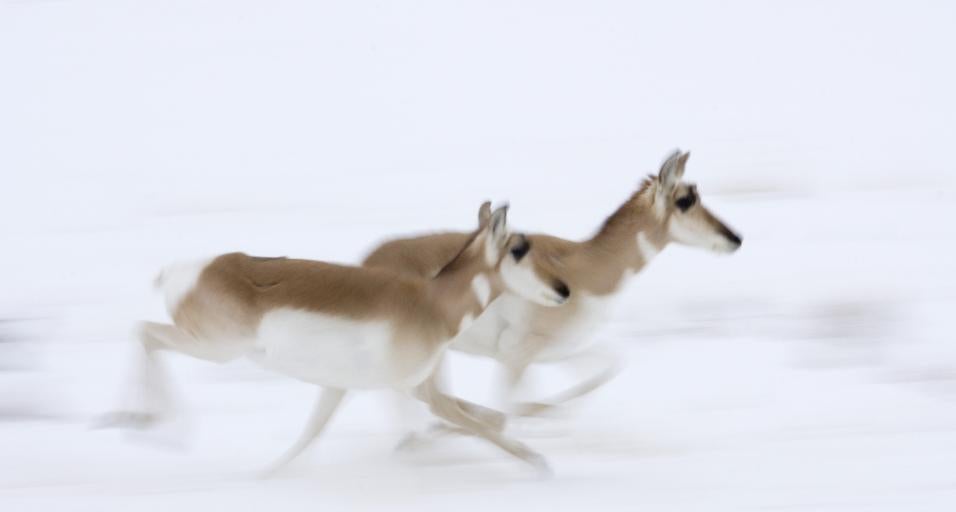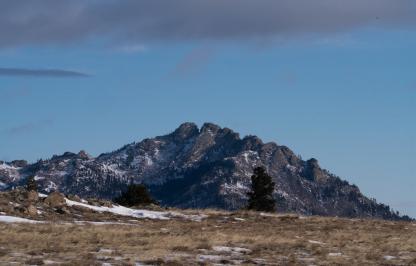Much of Wyoming is under a blanket of deeper than normal snow and those areas are also experiencing severe cold temperatures. While the harsh weather is beyond the control of the Wyoming Game and Fish Department, wildlife managers are monitoring the impact on big game, and responding to calls when wildlife conflicts occur. So far, Game and Fish biologists and game wardens are seeing an increase in numbers of big game dying than during past winters when conditions were more mild.
“Wyoming is no stranger to tough winters, but it has been a while since we have had a winter where widespread conditions were so hard on wildlife,” said Doug Brimeyer, deputy chief of the Game and Fish Wildlife Division. “All across Wyoming wildlife managers are keeping an eye on the public’s wildlife and monitoring the effects winter is having on big game, and concern is growing.”
At this time one of the biggest concerns is with public safety as some big game are moving onto roads and highways because of the deep snow. To reduce accidents Game and Fish urges travelers to please slow down and give big game space as they try to avoid areas with deep snow and find forage.
Harsh winters are not uncommon in the West. Wyoming’s big game have faced arctic-like conditions in years past, most recently in 2011. Impacts on big game can be significant during harsh winters, but the worst winter in recent memory was 1983-84 with populations rebounding within a few years.
“This is a critical time of the year for big game and their survival is dependant on their ability to conserve energy and find adequate forage,” said Brimeyer. “Wyoming’s elk, deer and pronghorn all have evolved to survive and cope in these conditions. Migrations are an example of a behavior that helps big game survive harsh winters.”
Across the state, reports detail early winter impacts on big game but much of the winter season’s outcome still remains to be seen until the spring.
CASPER
The Casper Region is reporting above average snowfall in many areas, especially south of Casper, in the Laramie Range and in the Black Hills. In addition, all areas within the region have experienced three separate protracted periods of bitter cold followed by extended periods of warming with sustained high winds. Generally speaking, winter conditions have been fairly harsh through mid-January. The region is also reporting some snow crusting that makes it more difficult for big game animals to feed and move.
Given the current winter conditions in the region, managers expect deer and antelope populations will experience some degree of elevated mortality, particularly in fawns. Fortunately, antelope and deer entered the winter in relatively good body condition, bolstered by a boost of nutrition and available forage that resulted from good fall moisture and a late season green-up of fall vegetation. Furthermore, the fall was extremely mild with extended periods of above-average temperatures lasting through mid-November. However, if late winter and early spring conditions continue to experience significant snow accumulation and additional cold periods, overwinter mortality may be higher than normal, and may even affect all age classes.
CODY
Winter severity near Cody has varied, with the most severe weather in the South and North Forks of the Shoshone River, Sunlight and Crandall areas. The City of Cody saw one of the most significant snow falls since the 1940s in December. Another significant snowfall in January added to the already deep snow depths in Cody and the South Fork and North Fork valleys of the Shoshone rivers. In addition, the extreme cold temperatures from Christmas persisted well into January. Temperatures have started to increase on the west side of the region recently, exposing some south facing slopes and ridges. The Cody region reports no significant winter mortalities of big game as of the first of the year in this area.
The rest of the Bighorn Basin has been experiencing the same cold temperatures; however, snow depths have been more moderate and normal for the year. Some deer mortality has been reported in the Shell and Greybull areas. Field personnel are monitoring the body condition of younger deer, and note it is starting to deteriorate. Antelope have moved to non-typical winter ranges. Big game mortality is not outside of the norm for this time of the year; however, higher than normal mortality for mule deer and antelope is possible.
GREEN RIVER
Since the first of the year, southwest Wyoming has been hit by several snowstorms and extreme cold. Continuous cold temperatures reaching as low as minus 44 degrees are beginning to take a toll on big game. Antelope, mule deer, elk and moose have been moving in an attempt to find forage and escape deep snow, and many antelope are trying to migrate south across Interstate 80 west of Green River. This has resulted in several instances where groups of animals have been hit by vehicles and trains.
The last time this area experienced similar winter conditions was during the 2010-11 winter, and Green River wildlife managers anticipate big game winter mortality to be higher than average. Field level observations indicate mule deer are starting to show signs of weakening, and mortality of the some younger age classes have been detected in the western half of the region.
JACKSON
Winter conditions continue to be difficult in the Jackson Region. Heavy snow and freezing/thawing, followed by sub-zero temps, have deeply crusted snow throughout much of the region. Shortly after the first of the year, storms deposited nearly four feet of snow in the mountains around Jackson and deep snow has forced elk and deer into conflict situations throughout the region. Mule deer in the region are particularly struggling as the animals move in search of food and of areas with shallower snow. Big game-vehicle collision are being documented in the region, with daily losses immediately south of Jackson. The region has been working with WYDOT and local NGOs to inform motorists to slow down and watch for big game through interactive signs and public service announcements.
LANDER
Winter has been fairly harsh throughout much of central Wyoming. Since mid-December the area has been hit with a succession of snowstorms and cold air fronts. The result is near-continuous snow cover from Waltman through the upper Wind River Valley, southern Wind River Range and Rawlins areas. The snow is hard packed and crusted in most areas.
During recent elk survey flights near Dubois, a large number of bull elk congregated in groups in the middle of winter range was noted. These bulls typically winter at higher elevations on the fringes of winter range. Snow and cold temperatures has forced them onto lower elevation winter ranges. Similar observations of elk lower than normal were made during recent flights in the southern Wind River Mountains.
Atlantic City and South Pass City recently received about 3-feet of snowfall. Most of the snow fell in areas where few big game animals spend the winter, except for moose. Moose in Atlantic City and in the Limestone, Pass Creek and Maxon Basin areas are fighting deeper snow than most winters, and shifts in winter distribution, along with elk, have been observed.
Although January has been characterized by harsh winter conditions, big game entered winter in good shape, thanks to an extremely mild fall and warm early winter. Winter impacts for deer and antelope remain to be seen until the spring for central Wyoming.
LARAMIE
Winter conditions in southeast Wyoming vary from open grassy fields and hillsides near the Nebraska line to the eastern face of the Laramie Mountains where more than 90 inches of snow have been reported. The January 10-11 storm that brought nearly 22 inches of snow in Laramie deposited approximately 4-feet of snow in the mountains and roughly seven days of below zero temperatures. Overall, conditions are improving; snow has either been melting or blowing away, making forage more available to wildlife. Laramie region wildlife managers are optimistic about winter survival, forecasting typical winter mortality rates at this time, but the managers are still concerned about the potential effect of spring snow storms.
PINEDALE
In the Pinedale and Big Piney areas, some deer mortality on the winter ranges is being documented. Mortality rates are not yet considered extreme; but, it is too early to predict the full impact of winter. However, with the early and prolonged severe cold weather, including minus 45 temperatures, and building snowpack, it is anticipated that the region will see above normal winter mortality for deer this year. Fortunately, the snow is not crusted. During a recent flight south of Pinedale, more mule deer mortalities than usual for the date were observed. But, the number of fawns on winter ranges was still satisfactory and the proportion of bucks appeared to be higher than previous years.
SHERIDAN
Much like other areas of the state, December and January were very cold in north-central Wyoming. Sheridan had the 10th coldest December in the last 110 years and the coldest since 1992. Snow water equivalents in the Powder River drainage ranged from 60 percent to 120 percent and in the Tongue River drainage from 94 percent to 150 percent. The deepest and most persistent snow in the Bighorn Mountains appears to be in the Sheridan and Dayton areas. The Gillette, Buffalo and Kaycee areas have received a limited number of big game mortality reports. Big game are trying to move or migrate through crusty snow conditions. In the Moorcroft area, where there are hard snow drifts, some deer mortality has been reported, and antelope are trying to migrate to areas with less snow. In the Sheridan and Dayton areas, deer mortality is on the rise, and elk have moved away from some typical wintering areas. Wildlife managers are anticipating an impact on big game in specific areas of the region due to harsh winter conditions.
The remaining winter
During the remaining winter, Game and Fish urges the public to keep big game survival, health and safety in mind. Winter conditions have increased big game-vehicle collisions, so motorists are encouraged to stay alert for big game on the road and reduce speeds in areas frequented by animals. Additionally, Game and Fish does not support localized, back-yard feeding of big game.
“Feeding big game the wrong foods and in the wrong places often causes more harm than good and does not measurably increase the chances of survival,” said Brimeyer. “Game and Fish recognizes and appreciates people’s concern about wintering big game, but pronghorn, deer, elk and moose digestive systems cannot adapt effectively to most types of feed during severe winters, and they will often die as a result. In particular, deer and pronghorn need very specific types of food and in the past we have seen situations with deer, antelope and moose dying with full bellies of hay and grain.”
The public can also help big game by staying off winter ranges, many of which are closed to human presence during the winter months, and limiting contact with big game on the move.
“Give your big game a break by keeping safe and adequate distance where possible and remember that spooking animals causes them to unnecessarily burn fat reserves needed for survival. We are early in this winter and still have months to go. By limiting disturbance, big game has the best chance to make it through this difficult time, despite the cold and snow,” said Green River Wildlife Management Coordinator Mark Zornes.
Game and Fish’s priority for the coming months will be to continue addressing wildlife conflicts, monitoring populations and informing the motorists and public about wintering wildlife.
Cold temperatures and deep snow taking a toll on Wyoming big game
Wyoming Game and Fish (307) 777-4600


